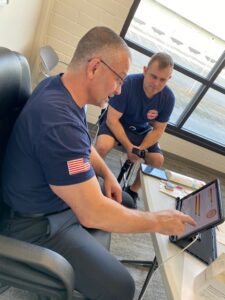3D Movement Assessment

 How a sport or tactical athlete moves is one of the most telling aspects for injury potential and performance enhancement. Movement will dictate how the joints are loaded, how force is distributed about the joint and how force is produced and transferred across the system. Poor movement leads to not only traumatic and overuse injuries but also has a direct impact on speed (in 10 yard dash), power and endurance. How one joint moves relative to another gives us a direct insight to what muscles are weak and which are tight. Knowing this, we can create targeted programs to address these deficits and improve performance, mitigate risk for injury and rehabilitate more efficiently and with a better long term outcome.
How a sport or tactical athlete moves is one of the most telling aspects for injury potential and performance enhancement. Movement will dictate how the joints are loaded, how force is distributed about the joint and how force is produced and transferred across the system. Poor movement leads to not only traumatic and overuse injuries but also has a direct impact on speed (in 10 yard dash), power and endurance. How one joint moves relative to another gives us a direct insight to what muscles are weak and which are tight. Knowing this, we can create targeted programs to address these deficits and improve performance, mitigate risk for injury and rehabilitate more efficiently and with a better long term outcome.
As physical therapists (the movement profession) we think we know how to evaluate movement. However, research simply does not support that. The current tests and methods we use are to subjective and rely on visual interpretation of movements occurring at 200 to 300 degrees per second (way faster than the human eye). That is why Dr. Nessler (founder of The Athlete Lab) developed the ViMove+ AMI. This uses wearable sensor technology to capture and record human movement with lab quality data. To help physicians, clinicians and strength coaches better evaluate movement with a high degree of accuracy. Whether you are a sport or tactical athlete, your future joint health depends on it. At the Athlete Lab, we offer the ViMove+ AMI, developed by Dr. Nessler. This assessment is typically done for one of three reasons:
- Rehabilitation or Return To Sport
- Performance Enhancement
- Injury Prevention

ViMove+ AMI – One of the scariest decisions about going back to sport after an ACL reconstruction or any injury is “when is the right time”? Currently, there is NO STANDARD for making that decision. Typically, we rely on some timeline the MD gives us or some test our therapist/athletic trainer does or (if your lucky) some kind of computerized strength test (Biodex). No fault, that was all that is typically available. In an ideal world, one would do what we did at Andrews and the American Sports Medicine Institute. Bring them into the lab, put a bunch of dots all over them and test them with the Vicon system (gold standard for assessing movement). But doing this takes a lot of time (4 hours – testing and generating results), it is expensive and those labs are hard to find.
This is where the ViMove+ AMI (Athletic Movement Index) comes into play. This was developed out of a frustration by Dr. Nessler. Back in the late 90s, a fairly new clinician became known for his work with ACLs. Over a 2 week period, he had 22 ACLRs in his office. He quickly became frustrated because there was no standard way of assessing return to sport after ACLR. In those days, we did not have the tech we have today so he set out to create a standardized way to do this. 2017 the first version of the AMI (ViPerform AMI) was released to the market. V2.0 ViMove+ AMI was released in 2022. Now, collectively, this has become the largest objective movement data base in the world with data on over 90,000 sport & tactical athletes across 5 countries.
The ViMove+ AMI is now becoming one of the best choices for making more informed return to sport decisions.
The Athlete Lab Return to Sport & Performance Testing Includes:
- Completion of TSK-11 – measure of athlete’s psychological readiness for return to play. Psychological status has a direct impact on movement and movement has a direct effect on psychological status.
- ViMove+ AMI Test – 4 wearable sensors are worn during performance of the Athletic Movement Index. The test will provide:
- Overall movement score

- AMI Rating
- Loss of balance (LOB) and LOB LSI
- Aggregate LSI – based on LQI scores on each limb during performance of multiple tasks
- LSI – limb symmetry index – compares performance on the right side versus left on each rep on each task
- LQI – limb quality index – is a measure of quality of movement during each rep of each task and is based on dynamic valgus, speed of valgus pelvic, degree of pelvic motion, and depth of motion.

- Overall movement score
- Acceleration/Deceleration Test – 2 wearable sensors are worn during performance and a maximal acc/dec 10 yard sprint. This provides:
- GRF
- IPA
- LSI
Your AMI Certified Sports Physical Therapist will review the results with you.
For athletes who are currently in the ACL rehab process, a modified version of this can be done to assess progress with rehab prior to being released to return to sport testing. This ensures that base level deviations are being addressed prior to going to the more complex and explosive movements.
Price: $300
TIme: 90 minutes
